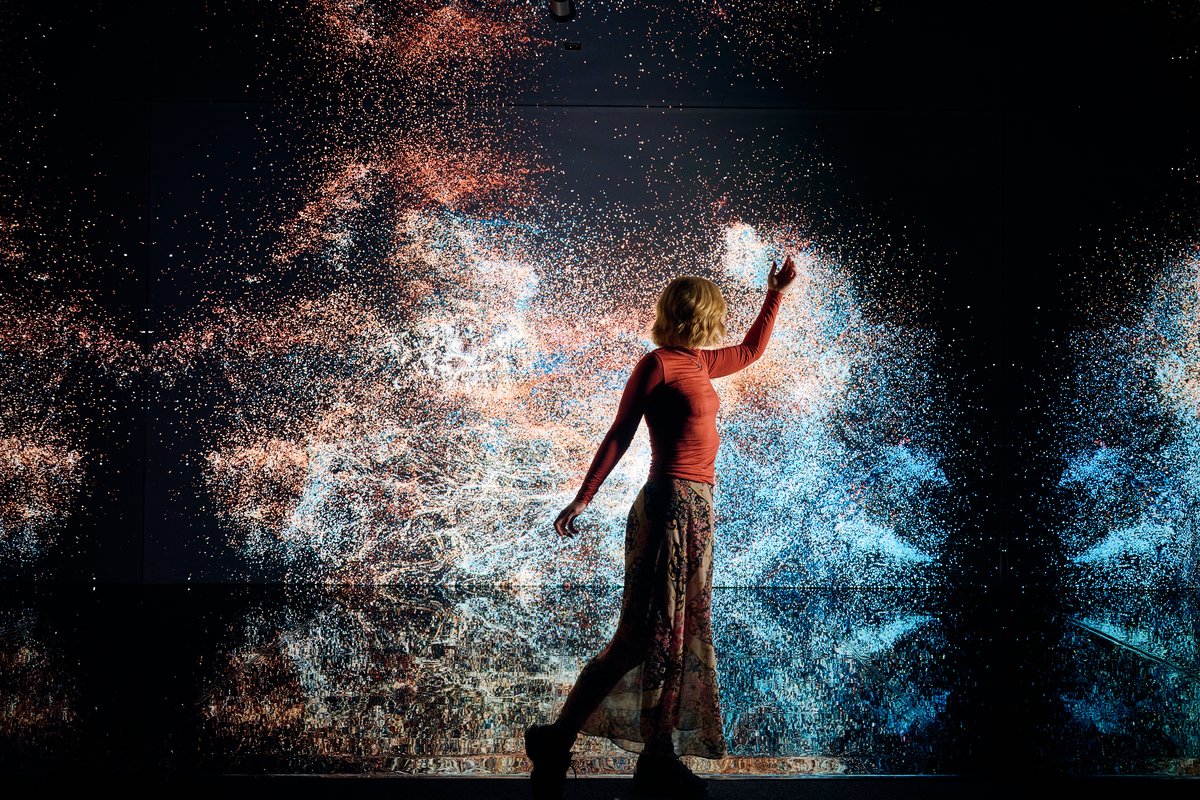Marshmallow Laser Feast invites you to experience the formation of a black hole with their immersive artwork, Distortions in Spacetime.
In a giant star’s final moments, atoms compress to a point where density becomes infinite, time stretches to a stop and the gravitational field is so strong that not even light can escape: a black hole.
But the force that creates this dark shadow also spews out a supernova explosion of matter that can eventually coalesce to form planets, plants and people. In the work, visitors will see themselves reflected in this matter, exploring the cosmic connection between black holes, dying stars and our very existence.
The Scale of Things
Our concept of reality is entwined with how our bodies are structured to perceive the world. Scientific inquiry, probing the nature of nature, reveals a much broader spectrum of reality that lies beyond our perception.
In 1916, Albert Einstein predicted the existence of black holes through the equations of general relativity. Now we can use those same equations to explore the fluid nature of spacetime, in and around the most extreme place in the universe – the singularity of a black hole.
Here, beyond observation and human experience, only mathematics and imagination can comprehend what could or could not be. Distortions in Spacetime and The Scale of Things explore the science behind black holes and gravitational waves, revealing the cosmic connection between black holes, dying stars and you.
The Overview Effect
When astronauts first looked back at Earth from space, they were awestruck and humbled to see the world in its immensity and insignificance. This new perspective caused a cognitive shift in awareness known as the overview effect. It places humans as one tiny part of a vast, interlinked ecosystem – not the centre. We can get the same effect by looking at enormous canyons or stunning mountain ranges. It’s not just natural phenomena that can provoke awe and wonder though, it can be epic virtual landscapes or a VR journey through our own branching bodies.
This shift evokes a unique pattern in our brains that disrupts the area responsible for the ego and the self. Experiences of awe can have a lasting effect, increasing people’s kindness and connection to nature – the only proven driver of pro-environmental behaviour. It’s a powerful transcendent state with personal, social and environmental impact.
“There is so much emotion and beauty in science, and so much that takes place beyond the limits of our perception. If we could stand on the edge of a black hole and peer in, what astounding, undulating cosmic forces might we see? Life, death and everything in between, entwined in a dance as long as time?”
– Barnaby Steel of Marshmallow Laser Feast
Works of Nature Soundscape: Death
While developing the artworks featured in Works of Nature, Marshmallow Laser Feast conducted a series of interviews with the foremost thinkers on nature, life and the more-than-human world. These include internationally renowned cultural ecologist and geophilosopher Dr David Abram, Professor of Plant-Soil-Processes at the University of Sheffield Katie J Field, author and founder of Schumacher College Dr Stephan Harding, and biologist and bestselling author Dr Merlin Sheldrake.
In the below soundscape, they question – since everything is connected (according to science) – can anything ever really die?
Artist video
Below, Ersin Han Ersin wanders among the Victorian landscape and explains Marshmallow Laser Feast's connection to nature.
Related articles
Related works
Content notification
Our collection comprises over 40,000 moving image works, acquired and catalogued between the 1940s and early 2000s. As a result, some items may reflect outdated, offensive and possibly harmful views and opinions. ACMI is working to identify and redress such usages.
Learn more about our collection and our collection policy here. If you come across harmful content on our website that you would like to report, let us know.
How to watch
Works in this group have been digitised and are viewable by following the links below.
Collection
Not in ACMI's collection
Previously on display
14 April 2024
ACMI: Gallery 4
Collection metadata
ACMI Identifier
195683
Materials
Real-time video installation, multichannel audio




